Salmon Family - A "Fishy" Tale or Two
The story of our Salmon family starts in Dublin, with William Salmon.
William Salmon (1797 - 1852)
William Salmon was born about 1797 in Dublin. William married Rose Loughlin (Laughlin), who was born about 1803, on 18 August 1823 in Rathfarnham, Dublin. The witnesses to the wedding were James and Mary Salmon. Children of this marriage were:
- Bartholomew (1823 - ?)
- Ellen (1824 - ?)
- Catherine (1828 - Before 1842)
- Thomas (1829 - ?)
- James (1834 - ?)
- Mary (1836 - 1904) married i) Edward Elliott, ii) Jonathan Watson
- Martha (1838 - ?)
- Catherine (1842 - 1844) n.m.
On 23 July 1830, William was committed to Kilmainham Gaol. He was released 10 September 1830. No further details are known at this time in relation to the charge.
The Salmon family spent various periods of time in the South Dublin Poor Union Workhouse. On 14 November 1843 Rose, together with her children James, Thomas, Mary, Martha and Catherine were admitted to the Workhouse. Rose's occupation was listed as Wool Carder Picker. The family's "Electoral Division and Townland in which resident" was listed as Whitechurch. William was listed as "in England" and number of children recorded as "4 in house".
At a meeting of the Board of Guardians of the Workhouse on 11 January 1844, the Master reported that several "pauper nurses were sent to the Police Office charged with riot and assault by Nurse Hayden", these nurses were Rose Salmon, Margaret Edwards, Mary Ryan, Mary Cunningham and Eliza Green. He went on to report that "after the investigation, the Magistrate postponed sentence until 2 o'clock on Friday the 12 int (sic) as the women expressed sorrow for their improper conduct and promised amendment".
Rose was discharged from the Workhouse on 29 April 1844. This is the last mention I have found of Rose. By 1849, William was listed as a widower, which would suggest that Rose died sometime between 1844 and 1849. Further research is required to determine when and where Rose died.
William was admitted to the Workhouse on 8 May 1849, on admittance his occupation was Wool Spinner he was listed as being a widower, Roman Catholic, aged 57, wearing old clothes. He was discharged 5 July 1849. William was again admitted to the workhouse on 3 May 1852. He died there 5 May 1852.
Bartholomew Salmon (1823 - ?)
Bartholomew was born about 1823 in Dublin. He was baptised on 26 August 1823 at Rathfarnham Dublin. His godparents were Phil Comerford and Mary Anne Salmon. Nothing further has been found about Bartholomew at this time.
Ellen Salmon (1824 - ?)
Ellen was born about 1824 in Dublin. She was baptised on 14 November 1824 at Rathfarnham Dublin. Her godparents were James ? and Mary Tool. An Ellen Salmon, aged 23, was admitted to the South Dublin workhouse in 1849, and discharged on 30 July 1849. Further research is required to determine if she was the same Ellen.
Catherine Salmon (1828 - ?)
Catherine was born about 1828 in Dublin. She was baptised on 12 March 1828 at Rathfarnham Dublin. Her godparents were Michael Salmon and Mary Ann ?. Nothing further has been found about Catherine at this time, however, as William and Rose named another daughter Catherine in 1842, it is assumed that she died sometime between 1828 and 1842. Further research is required.
Thomas Salmon (1829 - ?)
Thomas was born about 1829 in Dublin. He was baptised on 5 July 1829 at Rathfarnham Dublin. His godparents were Thomas and Bridget ?.
On 14 November 1843 Thomas was admitted to the South Dublin Workhouse with members of his family, they were discharged on 29 April 1844. On 14 December 1846, Thomas was again admitted to the South Dublin Workhouse, he was discharged 16 June 1847.
On 24 June 1847, Thomas was committed for stealing bread. He was sentenced to 14 days and released on 7 July 1847. On his committal papers, he was described as age 18, 5 ft 51/2 inches tall, dark hair, swarthy complexion, place of birth Rockfield, occupation Labourer, Catholic, and he could read.
Thomas was again admitted to the South Dublin Workhouse on 2 August 1847. During this time, Thomas appeared several times in the Reports of the Master and Other Officers. On one occasion Thomas, together with a William McCormack, were reported for stealing turnips. Their punishment was to be confined for 10 hours per day for 2 days and to receive half diets. On 15 May 1848 Thomas was reported for having a quart of Stirabout (an oatmeal drink / porridge) under his jacket which he could not account for and refusing to give it to Wardmaster Doherty to be discharged. He was discharged 17 May 1848.
Thomas was again admitted to the Workhouse on 19 June 1848 and discharged on 13 November 1848. On 14 November 1848 he was committed for "loitering about with intent to do an injury". His sentence was "24 hours confinement or fixed bail". He was released on 15 November 1848 on expiration of his sentence. His occupation was recorded as Factory Boy, aged 19, with blue eyes, brown hair and fair complexion.
As there were at least two Thomas Salmons living in the Dublin area in the same period (the second one was the son of John and Mary Salmon, and married Kate Neil in Dublin in 1866), it is difficult to determine if subsequent mentions of Thomas Salmon are our Thomas or not. Throughout the 1850s and 1860s a Thomas Salmon appeared in Petty Sessions Court Registers numerous times, complaints were made against him for allowing his cow(s), goat(s) and/or ass to wander on the public road at Collinstown, he was fined on each occasion. In 1868 a Thomas Salmon was fined (with a Patrick Salmon) for assaulting James Joyce (not the writer). Unfortunately, none of these reports/documents include details to identify which Thomas it was.
A Thomas Salmon died in Jan - March 1892 in Dublin South, aged 62 (which would be the correct age). Further investigation is required to confirm if he is our Thomas.
James Salmon (1834 - ?)
James was born about 1834 in Dublin. He was baptised on 1 March 1834 at Rathfarnham Dublin. His godparents were Stephen Bergin and Mary Carroll. Nothing further has been found about James at this time.
Mary Salmon (1836 - 1904)
Mary Salmon has certainly been an interesting person to trace, it has taken many years to sort through the fact from the fiction, and to work out what her real name was. Mary was born about 1836 in Dublin. She was baptised on 25 April 1836 at Rathfarnham Dublin. Her godparents were James and Anne Moffitt.
In 1843 Mary was admitted to the South Dublin Workhouse with her mother, her brothers James and Thomas, and her sisters Martha and Catherine. At this time, Mary's father was listed as in England. The family were discharged from the Workhouse on 29 April 1844.
Mary was admitted to the workhouse again on 7 March 1848. On the same day, at the Meeting of the Board of Guardians, it was agreed that a letter should be sent to Mary's father, who was working for Mr McCracken of Clare (?) ( writing makes it hard to decipher where her father was living/working). Mary was discharged on 30 March 1850. On 8 April 1850, she was one of the "Irish Orphans" on the "Tippoo Saib", which set sail from Plymouth. It landed in Sydney on 29 July 1850. On arrival, the Irish Orphans were placed at the Hyde Park Barracks, pending being placed "in service" (i.e. indentured). How long Mary remained at Hyde Park Barracks is unknown.
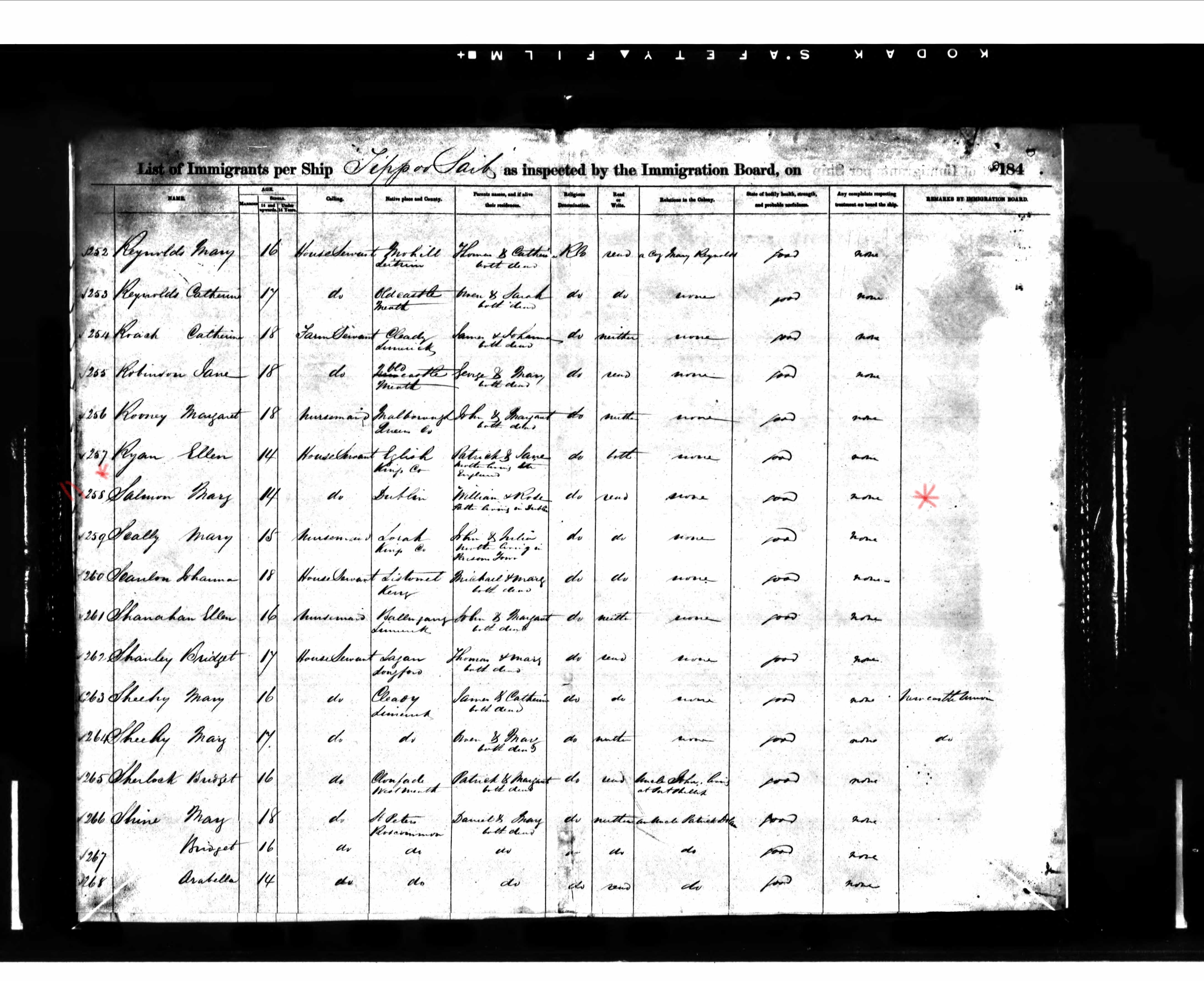
Mary Salmon's shipping record
It appears that Mary was first indentured to a Mrs Leeke. At this time, no further details are known about Mrs Leeke, other than she most likely lived in Sydney. It is not known when Mary commenced her indenture with Mrs Leeke. What is known is that on 21 March 1851 the indenture was cancelled for "disobedience". It was quite common for false claims to be made against the Orphan Girls so that the indenture could be cancelled. For an indenture to be cancelled, valid legal grounds for were "insolence", "disobedience", "improper conduct", "absconding" or "neglect of duty" on the part of the apprentice or servant.
In 1855 a New South Wales Parliamentary Enquiry was held as a result of a petition by the Celtic Association. They had complained about comments made by the Immigration Agent, H H Browne, in his 1855 report. Browne stated that Irish female immigrants were unsuitable to the requirements of the Colony, and that they were distasteful to the majority of people. As part of his defence, Browne provided "Return of Cases of Orphan Female Apprentices whose Indentures were cancelled, by the Court of Petty Sessions, at the Water Police Office". The cancellation of Mary Salmon's was one of the many cancellations included in the return. This submission was then included as evidence by the Select Committee on Irish Female Immigration in 1858.
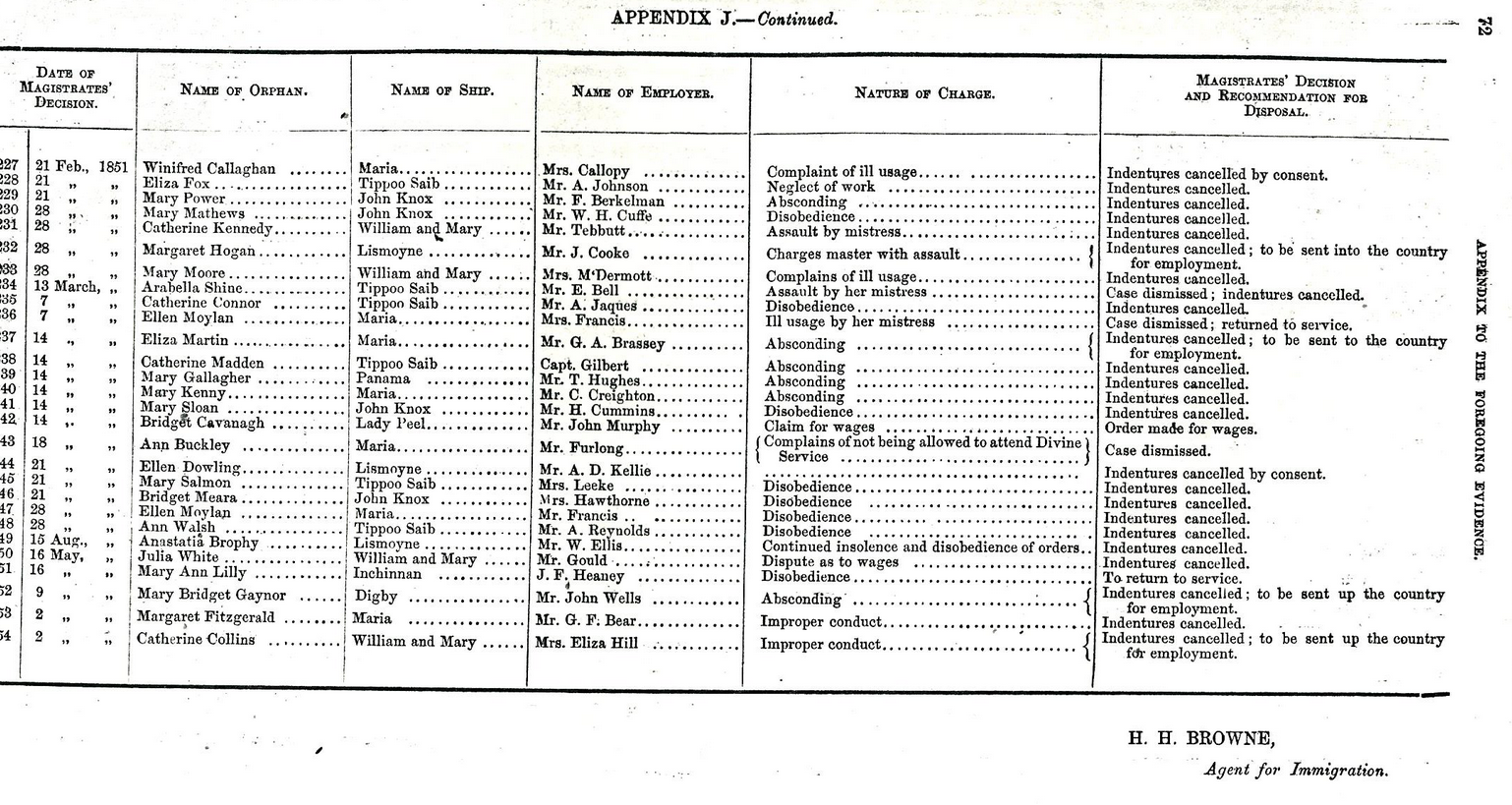
Appendix J Minutes of Evidence taken before the Select Committee on Irish Female Immigration
(Sourced from Trevor McClaughlin's blog post
"Earl Grey's Irish Famine Orphans" (22): Cancelled Indentures")
But back to Mary. When indentures were cancelled, orphans were returned to the Hyde Park Barracks, so it can be assumed that this was where Mary returned. The orphans who were returned to the Barracks after their indentures were cancelled were subjected to more severe discipline. On 31 January 1852, Mary was one of five orphan girls transferred from Sydney to Maitland. In the letter from the Agent for Immigration (H H Browne) to the Police Magistrate in Maitland, the agent advised that the girls had all been invalids and "are not therefore at present suited for the situations of General House Servants, but they may be placed in service as nursing girls or such other light situations."
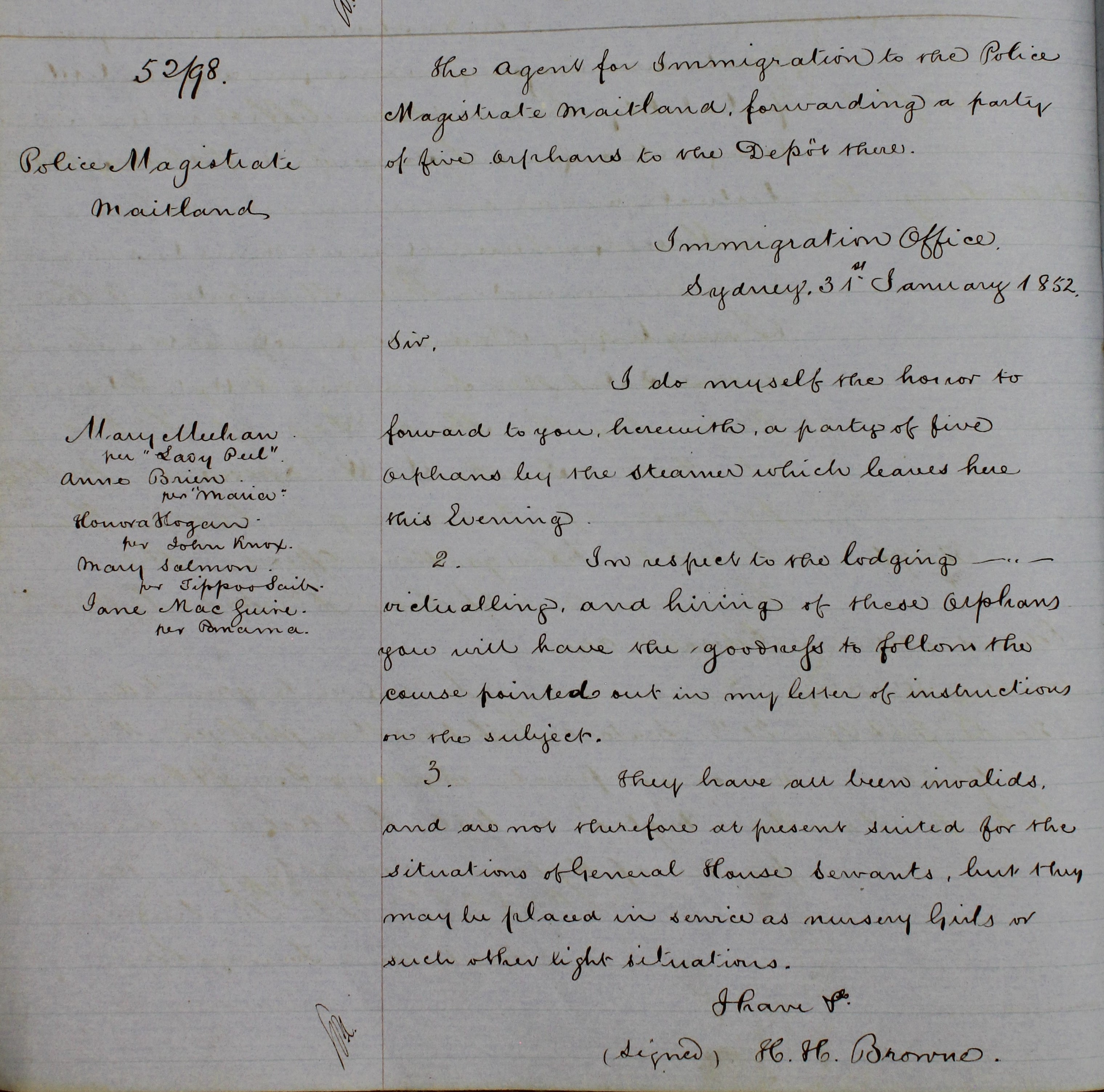
Mary Salmon transferred to Maitland
In February 1852, Mary was hired by Francis Dale, a school master of Maitland, and his wife Grace as a domestic servant. According to the newspaper report below, on 2nd April 1852 Mary was turned away by Mrs Dale, without notice, which breached the agreement between Mary and the Dales. Mary took Francis Dale to court, to claim wages and a discharge. The case was dismissed. At the time, there was a lot of bias against the Irish Orphans, and it also has to be remembered that Francis Dale was on trial, so his claims should not be taken as fact.
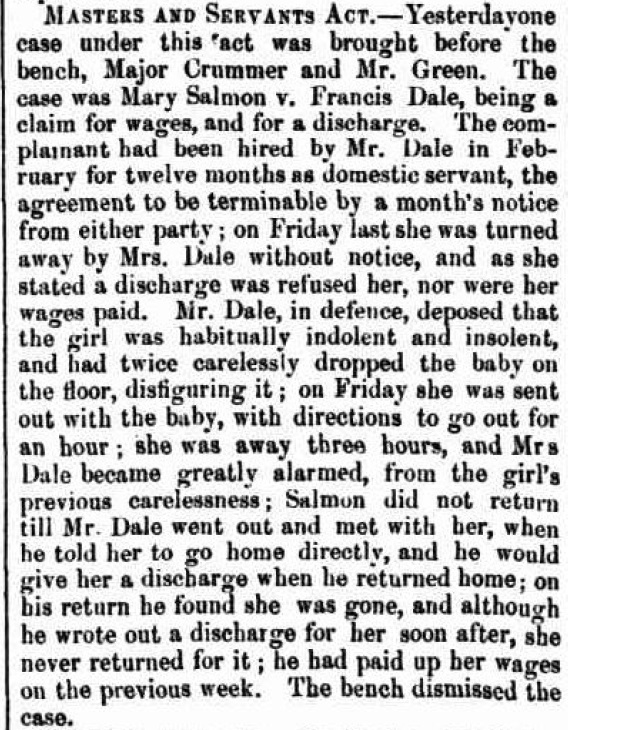
Mary Salmon court case
(The Maitland Mercury and Hunter River General Advertiser Wednesday 7 April 1852)
Where Mary went after this is unknown, but it is possible that she was returned to the Immigrant Depot at Maitland. The next known reference to Mary is in 1854. By this time, she was known as Mary Ward. It is not known if she had married, or if she had just taken on this new surname. On 28th April 1854, George Hancock appeared in court, charged with illegaly selling rum. He was found not guilty. One of the witnesses was Mary Ward, who in evidences given by other witnesses was “passing as Mrs Hancock” on the night in question. This would suggest that Mary and George never married. As part of the prosecution’s case, evidence was given that Mary Ward had sold the rum for George Hancock. On 26th May 1854, Mary Ward appeared in court, facing the same charge. Mary was found guilty, and fined 30 pounds and costs to be paid in seven days or a distress warrant to be issued. On 17th June 1854, Mary was admitted to Newcastle Gaol, sentenced to three calendar months confinement in default of paying a 30 pound fine. Her gaol papers show she arrived on the Tippoo Saib (so this IS Mary Salmon), that she was admitted to gaol with her child (most likely Edith Grace, who was born about 1853), that she was 5 foot 2 inches, had blue eyes, was fresh faced and freckled and a scar on her chin. At this time, she would have been about 20 years of age. She also claims to have been born in Yorkshire. This is consistent with information recorded on some of her children’s birth certificates, where she was listed as being from Yorkshire. Mary was discharged from the gaol on 15th September 1854.

George Hancock court case
(The Maitland Mercury and Hunter River General Advertiser Wednesday 3 May 1854)
On 26th May 1854, Mary Ward appeared in court, facing the same charge. Mary was found guilty, and fined 30 pounds and costs to be paid in seven days or a distress warrant to be issued. On 17th June 1854, Mary was admitted to Newcastle Gaol, sentenced to three calendar months confinement in default of paying a 30 pound fine. Her gaol papers show she arrived on the Tippoo Saib, that she was admitted to gaol with her child (most likely Edith Grace, who was born about 1853 and who gave her maiden name as Hancock on the birth certificates of her children), that she was 5 foot 2 inches, had blue eyes, was fresh faced and freckled and a scar on her chin. At this time, she would have been about 20 years of age. She also claims to have been born in Yorkshire. This is consistent with information recorded on some of her children’s birth certificates, where she was listed as being from Yorkshire.

Mary Ward court case
(The Maitland Mercury and Hunter River General Advertiser Saturday 27 May 1854)

Newcastle Gaol Entrance Papers
Mary was discharged 15th September 1854. As Mary went back to George’s house in December to retrieve her belongings, it would seem that she didn’t resume her relationship with George on her discharge.
In 1855, Edward Elliott was charged with assaulting George Hancock at his house at Stoney Creek.
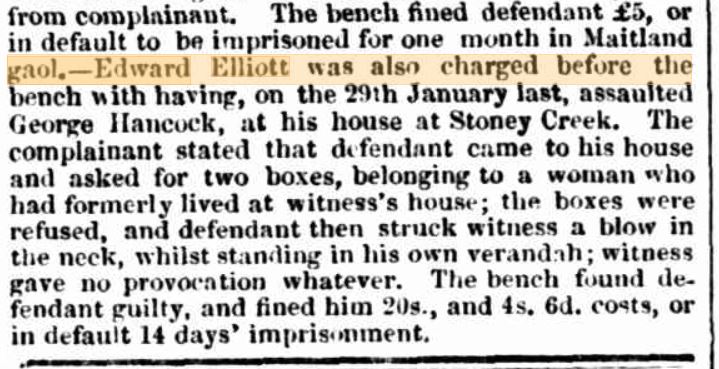
Edward Elliott Assault Charge
(The Maitland and Humter River General Advertiser 14 February 1855)
How Mary and Edward Elliott crossed paths is unknown. No record of the marriage has been found yet. From information recorded on the birth certificates of their children, the marriage was between 1852 and 1854. Where a full date has been provided, whilst the year varies, the date provided has been consistently 26 December. Based on the above information, it could be that they married 26th December 1854. Or if Mary was already married, maybe they never married. From information provided on their children's birth certificates, Edward and Mary had between eleven to thirteen children. Details of children found so far are:
- Abigail Elliott (1856 - 1857) n.m.
- Jemima Mary Elliott (1858 - 1858) n.m.
- William Edward Elliott (1859 - 1862) n.m.
- Martha (May) Rosine Elliott (1861 - 1947) n.m.
- Samuel James Elliott (1865 - 1927) married Dorathea Dunn
- Thomas Walter Elliott (1868 - 1944) married Elizabeth Fitzpatrick
- Lillian Lavinia Elliott (Abt. 1869 - 1953) married Archibald Frank Marcus Brooke
- Elizabeth Hannah Elliott (1872 - 1953) married John Thomas
For further information on the Elliott family, click here.
Mary married Jonathan Watson on 28 August 1873 in Coonabarrabran New South Wales. On her marriage certificate, she states that she was a widow. However there was one small problem, Edward was still alive at the time. He appears to have died in 1879. Children of this marriage were:
- Francis Jonathan Watson (1874 - 1944) married Mary Josephine Dillon
- Robert Watson (1877 - 1936) married Eleanor Jane Terry
- Arthur Richard Watson (1879 - 1938) married Annie May Eldridge
According to the birth certificates for the three Watson boys, Jonathan Watson was born in America. However other evidence suggests that he was born in England. On 9th January 1874, Jonathan was committed to trial at Coonabarrabran, charged with forgery. His trial was held in Mudgee in April 1874. He was found guilty and sentenced to two years hard labour at Darlinghurst Gaol. According to his admission papers, he was born in Liverpool England in 1834, and arrived in New South Wales in 1859 on the "Shamrock".
Family legend has it that Jonathan kicked his stepson, Thomas Elliott, out of the house, when Thomas was about 12 (about 1880). It is unknown if any of his (Elliott) siblings were also kicked out.
In 1886 a warrant was issued by the Bourke Bench for the arrest of Jonathan, he was charged with unlawfully deserting his wife at Dubbo. It was reported that he was accompanied by a boy of about 12 (their son Francis perhaps?) and that he was supposed to have been shearing at Pangee. Nothing more is known about this at this time.
Jonathan died 2 October 1900 and was buried at Rookwood Cemetery. The inscription on his headstone states "late of Girilimbone". This, combined with Jemima being the informant on his death certificate, which also stated that he was late of Girilambone, would suggest that he and Mary had reunited.
A J Watson was listed at Girilambone on the 1891 NSW Census. Mary lived in Girilambone for some years, she was listed as living there on the 1901 NSW Census. When she fell ill she was taken to Nyngan, where she died 31 July 1904, she was buried at Nyngan.
Part of the problem in finding details about Mary had been trying to determine what her maiden name actually was, and her use of "Jemima" in her name. According to her death certificate, her father's name was Alfred Austin. This appears to be one of the many "stories" that have been perpetuated about Mary. Her death certificate also states that she spent some time in Queensland and Tasmania. Whilst I have found evidence of her being in Queensland (her daughter Lillian was born there about 1869), I have not found any evidence of her having lived in Tasmania.
Mary's maiden name provided on the birth certificates of her Elliott children was variations on Salmon/Solomon/Sillilome. Her maiden name on the birth certificates of her Watson children was Austin. This appeared to be supported by Thomas Elliott's death certificate, on which Jemima's maiden name was given as Mary Jemima Austin Salamay. It appears that Mary may have changed some details about her past when she married Jonathan, to hide the fact that she was still legally married either to Edward or the (possible)unknown Ward. Mary was the informant on Jonathan Watson's death certificate, she gave her maiden name as Salmon. Please click here for more detailed analysis of Mary's names.
Edith Grace Hancock (1853 - 1883)
Edith Hancock was born about 1853. According to her children's birth certificates, she married Thomas Winslow in 1871 or 1872, either in NSW or Queensland. As yet, I haven't been able to find a record of their marriage. Edith and Thomas had 4 children:
- Mary Jemima Winslow (1874 - 1970) married Joseph Chaniel
- Emily Amelia Winslow (1876 - 1876)
- Rachel Caroline Winslow (1877 - 1945) married Theodore De Clabout
- Robert Thomas Winslow (1878 - ?)
In August 1882, it was reported that the three children had traveled to the Sydney Orphan School, their mother lived at Vegetable Creek and was in poor circumstances and was nearly blind, and their father could not be found. Edith died 26 April 1883 at Emmaville from measles.
Francis Jonathan Watson (1874 - 1944)
Francis Watson was born in 1874 in Mudgee. He married Mary Josephine Dillon in Nyngan in 1906. Francis and Mary had no children. Francis died in Hamilton in 1944.
Robert Watson (1877 - 1936)
Robert Watson was born in 1877 in Dubbo. He married Eleanor Jane Terry in Nyngan in 1906. Robert and Eleanor had 8 children:
- Herbert Thomas Watson (1904 - 1976) married Mary
- Robert Roy Watson (1907 - 1979) married Fanny Power
- Arthur Francis Jonathan Watson (1909 - 1973)
- Vera Watson (1911 - 1915)
- Eileen Mary Watson (1912 - 2007) married James Harcourt Wales
- Kenneth Watson (1918 - 1972)
- Mona Watson (1919 - 1922)
- Edith May Watson (1925 - 1995) married William Leslie Middleton
Robert died in Condobolin in 1936.
Arthur Richard Watson (1879 - 1938)
Arthur Watson was born in 1879 in Dubbo. He married Annie May Eldridge in Nyngan in 1907. Arthur and Annie had 2 children:
- Marjorie L Watson (1916 - 1929)
- Elwyn Arthur Watson (1922 - 1998)married Beryl Eugenie McGuigan
Arthur died 12 March 1938 at Dubbo.
Martha Salmon (1838 - ?)
Martha was born about 1838 in Dublin. She was baptised on 3 October 1838 at Rathfarnham Dublin Her godparents were Thomas Salmon and Mary Healy. She was not admitted to the Workhouse with the rest of her family, the most obvious reason could be that she had died before they were admitted. Further investigation is required.
Catherine Salmon (1842 - 1844)
From Workouse documentation, Catherine was born about 1842. She was admitted to the South Dublin Workhouse on 14 November 1843, with her mother, brothers Thomas and James, and sister Mary. She was discharged on 20 March 1844. The paperwork doesn't show where Catherine went, but it does record that she died 24 April 1844. Her recorded disability was idiocy.
Acknowledgements
With thanks to researchers on Who Do You Think You Are, who found evidence that Edward Elliott was still alive when Mary married Jonathan Watson, and who helped to prove that Mary was in fact Mary Salmon.
With thanks also to Trevor McClaughlin, and his blog Trevo's Irish Famine Orphans (click here to visit his blog. Trevor's site contains a wealth of information and case studies about the Irish Orphans and the times in which they lived, as well as his suggestions to put sources into context and allow for bias and prejudice.